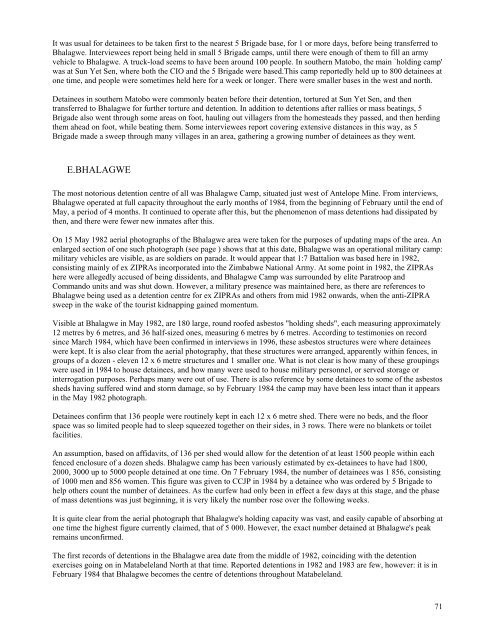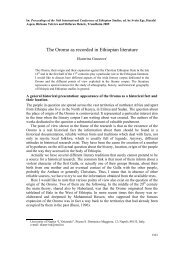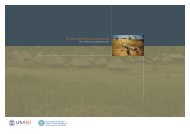MatabelelandReport
MatabelelandReport
MatabelelandReport
Create successful ePaper yourself
Turn your PDF publications into a flip-book with our unique Google optimized e-Paper software.
It was usual for detainees to be taken first to the nearest 5 Brigade base, for 1 or more days, before being transferred to<br />
Bhalagwe. Interviewees report being held in small 5 Brigade camps, until there were enough of them to fill an army<br />
vehicle to Bhalagwe. A truck-load seems to have been around 100 people. In southern Matobo, the main `holding camp'<br />
was at Sun Yet Sen, where both the CIO and the 5 Brigade were based.This camp reportedly held up to 800 detainees at<br />
one time, and people were sometimes held here for a week or longer. There were smaller bases in the west and north.<br />
Detainees in southern Matobo were commonly beaten before their detention, tortured at Sun Yet Sen, and then<br />
transferred to Bhalagwe for further torture and detention. In addition to detentions after rallies or mass beatings, 5<br />
Brigade also went through some areas on foot, hauling out villagers from the homesteads they passed, and then herding<br />
them ahead on foot, while beating them. Some interviewees report covering extensive distances in this way, as 5<br />
Brigade made a sweep through many villages in an area, gathering a growing number of detainees as they went.<br />
E.BHALAGWE<br />
The most notorious detention centre of all was Bhalagwe Camp, situated just west of Antelope Mine. From interviews,<br />
Bhalagwe operated at full capacity throughout the early months of 1984, from the beginning of February until the end of<br />
May, a period of 4 months. It continued to operate after this, but the phenomenon of mass detentions had dissipated by<br />
then, and there were fewer new inmates after this.<br />
On 15 May 1982 aerial photographs of the Bhalagwe area were taken for the purposes of updating maps of the area. An<br />
enlarged section of one such photograph (see page ) shows that at this date, Bhalagwe was an operational military camp:<br />
military vehicles are visible, as are soldiers on parade. It would appear that 1:7 Battalion was based here in 1982,<br />
consisting mainly of ex ZIPRAs incorporated into the Zimbabwe National Army. At some point in 1982, the ZIPRAs<br />
here were allegedly accused of being dissidents, and Bhalagwe Camp was surrounded by elite Paratroop and<br />
Commando units and was shut down. However, a military presence was maintained here, as there are references to<br />
Bhalagwe being used as a detention centre for ex ZIPRAs and others from mid 1982 onwards, when the anti-ZIPRA<br />
sweep in the wake of the tourist kidnapping gained momentum.<br />
Visible at Bhalagwe in May 1982, are 180 large, round roofed asbestos "holding sheds", each measuring approximately<br />
12 metres by 6 metres, and 36 half-sized ones, measuring 6 metres by 6 metres. According to testimonies on record<br />
since March 1984, which have been confirmed in interviews in 1996, these asbestos structures were where detainees<br />
were kept. It is also clear from the aerial photography, that these structures were arranged, apparently within fences, in<br />
groups of a dozen - eleven 12 x 6 metre structures and 1 smaller one. What is not clear is how many of these groupings<br />
were used in 1984 to house detainees, and how many were used to house military personnel, or served storage or<br />
interrogation purposes. Perhaps many were out of use. There is also reference by some detainees to some of the asbestos<br />
sheds having suffered wind and storm damage, so by February 1984 the camp may have been less intact than it appears<br />
in the May 1982 photograph.<br />
Detainees confirm that 136 people were routinely kept in each 12 x 6 metre shed. There were no beds, and the floor<br />
space was so limited people had to sleep squeezed together on their sides, in 3 rows. There were no blankets or toilet<br />
facilities.<br />
An assumption, based on affidavits, of 136 per shed would allow for the detention of at least 1500 people within each<br />
fenced enclosure of a dozen sheds. Bhalagwe camp has been variously estimated by ex-detainees to have had 1800,<br />
2000, 3000 up to 5000 people detained at one time. On 7 February 1984, the number of detainees was 1 856, consisting<br />
of 1000 men and 856 women. This figure was given to CCJP in 1984 by a detainee who was ordered by 5 Brigade to<br />
help others count the number of detainees. As the curfew had only been in effect a few days at this stage, and the phase<br />
of mass detentions was just beginning, it is very likely the number rose over the following weeks.<br />
It is quite clear from the aerial photograph that Bhalagwe's holding capacity was vast, and easily capable of absorbing at<br />
one time the highest figure currently claimed, that of 5 000. However, the exact number detained at Bhalagwe's peak<br />
remains unconfirmed.<br />
The first records of detentions in the Bhalagwe area date from the middle of 1982, coinciding with the detention<br />
exercises going on in Matabeleland North at that time. Reported detentions in 1982 and 1983 are few, however: it is in<br />
February 1984 that Bhalagwe becomes the centre of detentions throughout Matabeleland.<br />
71







